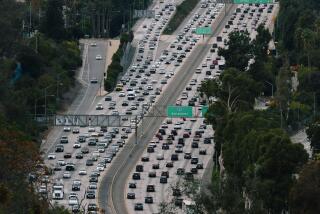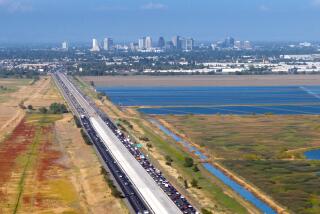Traffic on Toll Road Lags Projections; Fee May Be Reduced
- Share via
SANTA ANA — Traffic on the San Joaquin Hills toll road is running about 43% behind projections, prompting operators to consider a reduction in the $2 charge during weekends and evenings to entice more drivers to the road.
A ridership study released this week says the road will not draw as many cars as was predicted in 1992, when those projections were used to sell $1.4 billion in construction bonds. The bonds were sold in anticipation of 94,500 vehicle trips per day by April 1997. The road now handles about 54,000 trips daily.
The Transportation Corridor Agency board will vote Sept. 11 on a $1.2-billion refinancing package that involves more modest projections. The original prediction of 236,000 trips daily on the 15-mile highway by 2032 has been dropped to about 206,000 trips a day.
Lower interest rates to pay off the new bonds would allow the board to consider ridership enticements such as free days and dropping tolls during non-commute hours, said Lisa Telles, public affairs officer for the agency.
“With the current financing, our cushion is so tight, we couldn’t adjust the tolls,” she said Wednesday. “With new financing, we’ll have an opportunity to do some things with the tolls to see if it makes a difference [in revenues]. The board is definitely interested in looking at that.”
Dropping the tolls during peak commute hours isn’t being considered, she said. Officials have not said how much tolls could drop.
A controversy erupted in June over possible bond refinancing when the agency’s staff asked board members to sign a “confidentiality certificate” to prevent them from speaking publicly on the subject and closed meetings were held.
On Wednesday, Orange County Supervisor Todd Spitzer, a member of the tollway board, said approval of the refinancing package next week should be contingent on tolls that drop during non-peak times.
The new ridership study was based on daily usage since the first stretch of the highway opened in April 1996. It also factored in better economic information, including the effects of the county’s 1994 bankruptcy and the recession in Southern California that didn’t end until 1996, Telles said.
The new study was done by Wilber Smith Associates, the same company that produced the inflated estimates in 1992. Edward J. Regan, a company representative, told the tollway board last month that the skewed projections shouldn’t hurt the bond repayment schedule and that the county’s recovering economy should spur more use. Bond repayment is scheduled to begin in March 1999.
Spitzer, the only board member to question Wilber Smith’s traffic projections, said he isn’t satisfied with the explanation of why the numbers were so far off.
“I’m expecting to get the answers before I vote on this,” he said.
Telles said the company’s projections for the Foothill-Eastern tollway, completed for bond financing in 1995, are only 4% less than current ridership.
If the refinancing package is approved, the board hopes to sell the bonds at interest rates between 6% and 6.5%. That would compare to rates on the existing bonds that range from 5% to 9%, and would save about $30 million in the long run, Telles said.
“It only makes sense to refinance when interest rates are down,” she said.
The San Joaquin Hills tollway has been controversial since its inception, mostly because of opposition by environmentalists. The road cut through some of the most pristine coastal land in Orange County, opening it to increased development.
The first indication that the road wasn’t performing as well as projected came in May, when the tollway agency reported that it was receiving only 51% of anticipated revenue.
More to Read
Sign up for Essential California
The most important California stories and recommendations in your inbox every morning.
You may occasionally receive promotional content from the Los Angeles Times.










